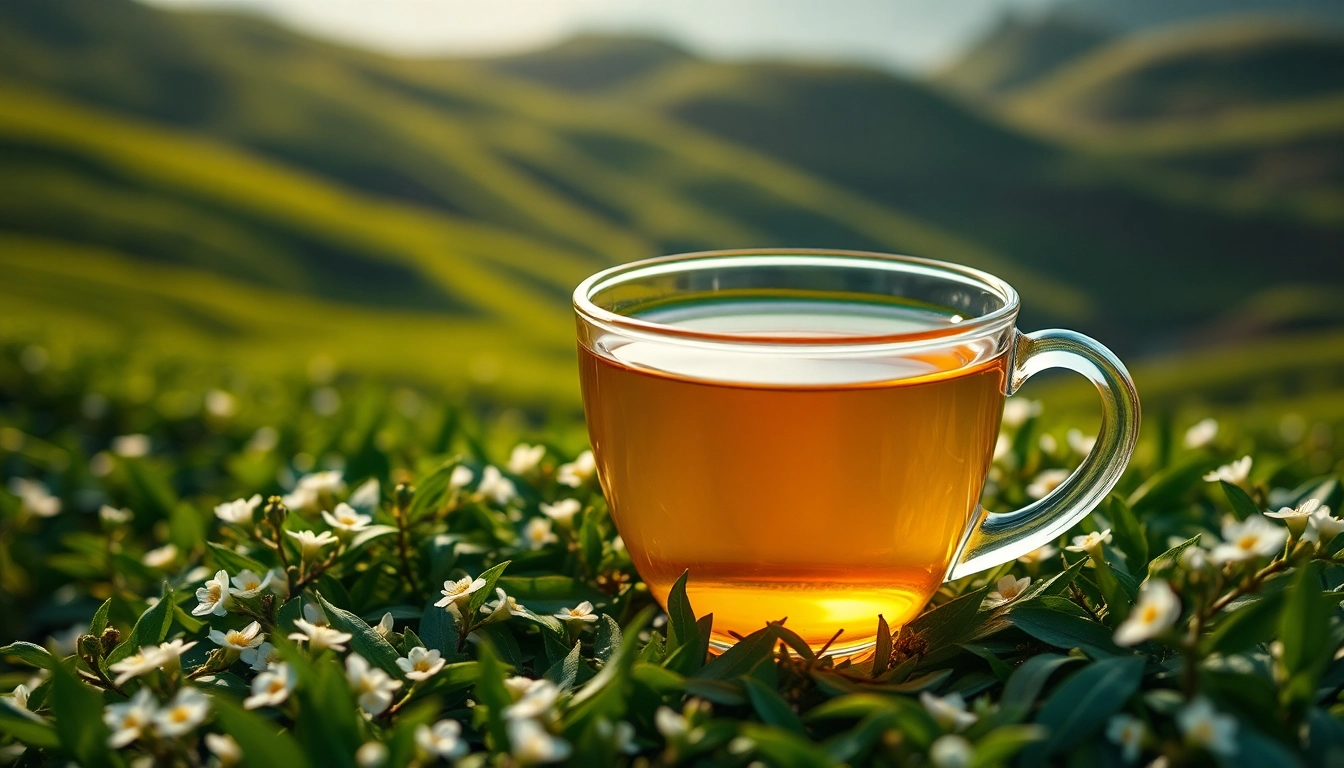The Essence of Nepali Tea
Nepal is not just a land of majestic mountains and rich cultural heritage; it is also home to one of the most exquisite beverages in the world—Nepali tea. This beverage, made from the leaves of the *Camellia sinensis* plant, is cultivated in the high-altitude regions of Nepal. Each cup serves as a cultural symbol, reflecting the traditions and expertise of Nepali tea growers. With its unique flavor profiles and diverse offerings, Nepali tea stands out in the global tea market, setting itself apart from its well-known neighbor, Darjeeling tea. In this article, we will explore what makes Nepali tea unique, the cultivation practices behind it, its distinctive flavors, health benefits, and how to brew the perfect cup.
What Makes Nepali Tea Unique?
Nepali tea is renowned for its distinct characteristics that arise from the unique geographical and climatic conditions of the regions where it is grown, particularly in the tea-producing districts of Ilam and Dhankuta. The high altitudes and fertile soils of the Himalayan foothills produce tea plants that thrive under specific conditions, allowing for the development of complex flavors. Moreover, the traditional artisanal practices employed by local farmers add a layer of individuality to each batch of tea.
What sets Nepali tea apart from other types, such as Darjeeling, is not only its flavor but also its fragrant aroma. The farmers in Nepal often employ organic cultivation methods, ensuring that the tea is free of harmful pesticides and chemicals. As a result, the leaves retain their natural flavors and aromas, attracting tea enthusiasts who prioritize quality and sustainability.
The Cultivation Practices in Nepal
The cultivation of Nepali tea involves careful attention to detail, with practices passed down through generations of skilled tea growers. Most tea plantations in Nepal follow organic farming principles, using natural fertilizers and pest control techniques that respect the environment and promote biodiversity.
The planting season typically begins in March, with the first annual harvest happening in April, known as the ‘first flush.’ This period is critical as the young, tender leaves are picked, resulting in a light and delicate flavor profile that is favored among many tea drinkers.
Moreover, manually harvesting the tea leaves ensures that only the highest quality leaves are selected. This dedication to quality is one of the reasons Nepali tea has gained international acclaim and awards in various tea competitions around the globe.
The Distinctive Flavor Profiles of Nepali Tea
Nepali tea boasts a rich diversity of flavors. Common profiles include floral, fruity, and muscatel-like notes, primarily influenced by the elevation and growing conditions. High-altitude teas from places like Ilam offer an exquisite balance of astringency and sweetness, making them delightful to sip.
Another defining feature of Nepali tea is its freshness. The careful processing methods, including withering, rolling, and oxidation, enhance the tea’s innate flavors. Each variety of Nepali tea—whether it be black, green, or white—displays a unique flavor profile that resonates with connoisseurs.
The connection between the land, the climate, and the craftsmanship of local farmers makes every cup of Nepali tea an experience worth savoring.
Types of Nepali Tea
Black, Green, and Oolong: An Overview
Nepali tea can be classified into several distinct types, with black, green, and oolong being the most notable.
- Black Tea: Generally characterized by its robust flavor and deep color, Nepali black tea is often compared to Darjeeling and Assam teas. The best varieties are harvested from the young leaves and buds, resulting in a smooth and rich infusion.
- Green Tea: This type is prized for its light, refreshing taste and is packed with antioxidants. Nepali green tea is less oxidized during processing, allowing it to retain more of its natural green color and health benefits.
- Oolong Tea: Known for its unique processing, oolong tea is partially oxidized, striking a balance between the qualities of black and green teas. Nepali oolong exhibits a variety of flavors, often with floral and fruity notes.
Famous Varieties from the Ilam Region
The Ilam region is particularly famed for its tea production, with several notable varieties that reflect the area’s unique terroir:
- Ilam Black Tea: This tea is aromatic, with flavor notes that range from fruity to floral, often enjoyed plain or with milk.
- Chamomile Black Tea: Infused with chamomile flowers, this tea offers a soothing blend ideal for relaxation.
- Jatamasi Black Tea: With unique earthy undertones, this variety incorporates the Jatamasi flower, known for its medicinal properties.
How Nepali Tea Compares to Darjeeling Tea
Both Nepali tea and Darjeeling tea are known for their high quality and exquisite taste, but several differences are apparent between the two.
While Darjeeling tea has a broader spectrum of processing styles, Nepali tea predominantly focuses on organic practices. Darjeeling tea often features more elaborate processing techniques that create a myriad of taste varieties but can sometimes rely on synthetic inputs. In contrast, Nepali tea capitalizes on its natural environment to develop flavors that are smoother and less astringent, making it a favorite among those seeking a more mellow experience.
Additionally, while Darjeeling has gained wider recognition globally, Nepali tea is quickly gaining traction for its quality and depth, promoting sustainable farming and ethical sourcing practices.
Health Benefits of Nepali Tea
Rich in Antioxidants and Nutrients
Nepali tea is packed with antioxidants, particularly polyphenols, which are known to offer a wide range of health benefits. These compounds help to combat oxidative stress in the body, potentially reducing the risk of chronic diseases such as heart disease and cancer. The high levels of catechins found in green and oolong varieties are particularly potent in promoting overall health.
Promoting Wellness and Hydration
Drinking Nepali tea is not just an enjoyable experience; it also supports hydration and can aid in digestion. Many varieties are known to have soothing properties that can relieve digestive discomfort and promote gut health.
Moreover, certain Nepali teas are imbued with herbal notes, often providing therapeutic benefits, such as reducing stress and improving focus. This makes it an ideal beverage for anyone looking to enhance their physical and mental well-being.
How to Incorporate Nepali Tea into Your Diet
Integrating Nepali tea into your daily routine can be a simple yet rewarding experience. Here are a few ideas:
- Morning Ritual: Start your day with a cup of invigorating black tea instead of coffee to enjoy a gentler caffeine boost.
- Afternoon Refreshment: Treat yourself to a refreshing green tea during the afternoon slump for a natural energy lift.
- Culinary Uses: Use Nepali tea as an ingredient in recipes such as tea-infused desserts or marinades.
Experimenting with different brewing times, temperatures, and additives can also enhance the flavor and enjoyment of your Nepali tea experience.
Brewing the Perfect Cup of Nepali Tea
Tools and Techniques for Brewing
To brew the perfect cup of Nepali tea, having the right tools and techniques is essential. The following items should be considered:
- Teapot or Brew Basket: A dedicated teapot for loose leaf tea can greatly enhance your brewing experience.
- Temperature-Controlled Kettle: Different teas require different water temperatures for optimal brewing.
- Tea Strainer: Essential for removing leaves from the finished brew.
Recommended Brewing Times and Temperatures
The ideal brewing parameters can vary by type:
- Black Tea: Brew at 95-100°C (203-212°F) for 3-5 minutes.
- Green Tea: Brew at 70-80°C (158-176°F) for 2-3 minutes.
- Oolong Tea: Brew at 85-90°C (185-194°F) for 3-5 minutes.
Following these guidelines will ensure that each cup of tea captures the essence of Nepali craftsmanship.
Enhancing Flavor with Additives
While Nepali tea can be enjoyed on its own, many choose to enhance its flavor with various additives. Common additions include:
- Milk and Sugar: Traditional for black tea, especially in preparing chai.
- Spices: Ingredients like cardamom, ginger, or cinnamon can introduce warmth and depth to your cup.
- Citrus: A slice of lemon or a zest of orange can elevate the zing factor in your tea.
Experimenting with different combinations will allow you to discover new ways to enjoy this delightful beverage.
Where to Buy Authentic Nepali Tea
Finding Trusted Suppliers and Brands
With the growing popularity of Nepali tea, finding authentic sources is easier than ever. Many reputable suppliers offer carefully sourced, organic options that ensure quality. When searching for Nepali tea, consider looking for brands that showcase their sustainability practices and sourcing stories.
Online retailers and local specialty tea shops often carry a variety of Nepali teas, allowing you to sample different types and discover which suits your palate best.
Understanding Packaging and Quality Indicators
When purchasing Nepali tea, pay attention to packaging and labeling. High-quality offerings often use biodegradable or recyclable materials to promote eco-friendliness. Furthermore, certifications such as organic or fair trade can serve as indicators of quality and ethical practices.
Online vs. Local Markets: Pros and Cons
Both online and local markets present their unique advantages and disadvantages:
- Online Markets: They offer a wider selection and often provide detailed product descriptions and customer reviews.
- Local Markets: Shopping locally allows you to discover unique varieties and gain insights from knowledgeable staff.
Choosing between the two will depend on your preferences for convenience and personal interaction.


